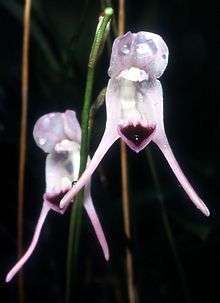Porroglossum
Porroglossum (from Greek "far off" and "tongue", referring to the position of the lip) is a genus of orchids native to the Andes of South America. The center of diversity lies in Ecuador, with many of the species endemic to that country, though others are found in Colombia, Venezuela, Peru, and Bolivia.[2][3] This genus is abbreviated Prgm in horticultural trade.
| Porroglossum | |
|---|---|
_-_Curtis'_125_(Ser._3_no._55)_pl._7664_(1899).jpg) | |
| Porroglossum muscosum 1899 illustration[1] | |
| Scientific classification | |
| Kingdom: | |
| (unranked): | |
| (unranked): | |
| Order: | |
| Family: | |
| Subfamily: | |
| Tribe: | |
| Subtribe: | |
| Genus: | Porroglossum |
| Synonyms[2] | |
|
Lothiania Kraenzl. | |
The lip in this genus is unique in the family. It is hinged and has a mechanism that snaps shut when stimulated by a pollinator, thus trapping the insect to ensure that the pollinia will be removed and later transferred to the receptive surface. The lip opens after 30 minutes or so to release the insect, but also closes at night and reopens at dawn.

Species
Species accepted as of June 2014:
- Porroglossum actrix Luer & R.Escobar
- Porroglossum adrianae Luer & Sijm
- Porroglossum agile Luer
- Porroglossum amethystinum (Rchb.f.) Garay
- Porroglossum andreettae Luer
- Porroglossum apoloae Luer & Sijm
- Porroglossum aureum Luer
- Porroglossum condylosepalum H.R.Sweet
- Porroglossum dactylum Luer
- Porroglossum dalstroemii Luer
- Porroglossum dejonghei Luer & Sijm
- Porroglossum dreisei Luer & Andreetta
- Porroglossum echidna (Rchb.f.) Garay
- Porroglossum ecuagenerense Luer & Hirtz
- Porroglossum eduardi (Rchb.f.) H.R.Sweet
- Porroglossum gerritsenianum Luer & R.Parsons
- Porroglossum hirtzii Luer
- Porroglossum hoeijeri Luer
- Porroglossum hystrix Luer
- Porroglossum jesupiae Luer
- Porroglossum josei Luer
- Porroglossum lorenae Luer
- Porroglossum lycinum Luer
- Porroglossum marniae Luer
- Porroglossum meridionale P.Ortiz
- Porroglossum merinoi Pupulin & A.Doucette
- Porroglossum miguelangelii G.Merino, A.Doucette & Pupulin
- Porroglossum mordax (Rchb.f.) H.R.Sweet
- Porroglossum muscosum (Rchb.f.) Schltr.
- Porroglossum myosurotum Luer & Hirtz
- Porroglossum nutibara Luer & R.Escobar
- Porroglossum olivaceum H.R.Sweet
- Porroglossum oversteegenianum Luer & Sijm
- Porroglossum parsonsii Luer
- Porroglossum peruvianum H.R.Sweet
- Porroglossum porphyreum G.Merino, A.Doucette & Pupulin
- Porroglossum portillae Luer & Andreetta
- Porroglossum procul Luer & R.Vásquez
- Porroglossum rodrigoi H.R.Sweet
- Porroglossum schramii Luer
- Porroglossum sergii P.Ortiz
- Porroglossum sijmii Luer
- Porroglossum taylorianum Luer
- Porroglossum teaguei Luer
- Porroglossum teretilabia Luer & Teague
- Porroglossum tokachii Luer
- Porroglossum tripollex Luer
- Porroglossum uxorium Luer
References
- H. T. D. (?)del., J. N. Fitch lith. ( = John Nugent Fitch, 1840–1927) Description by Joseph Dalton Hooker (1817—1911) - "Curtis's Botanical Magazine" vol. 125 (Ser. 3 no. 55)
- Kew World Checklist of Selected Plant Families
- Pridgeon, A.M., Cribb, P.J., Chase, M.C. & Rasmussen, F.N. (2006). Epidendroideae (Part One). Genera Orchidacearum 4: 1-672. Oxford University Press, New York, Oxford.
External links

